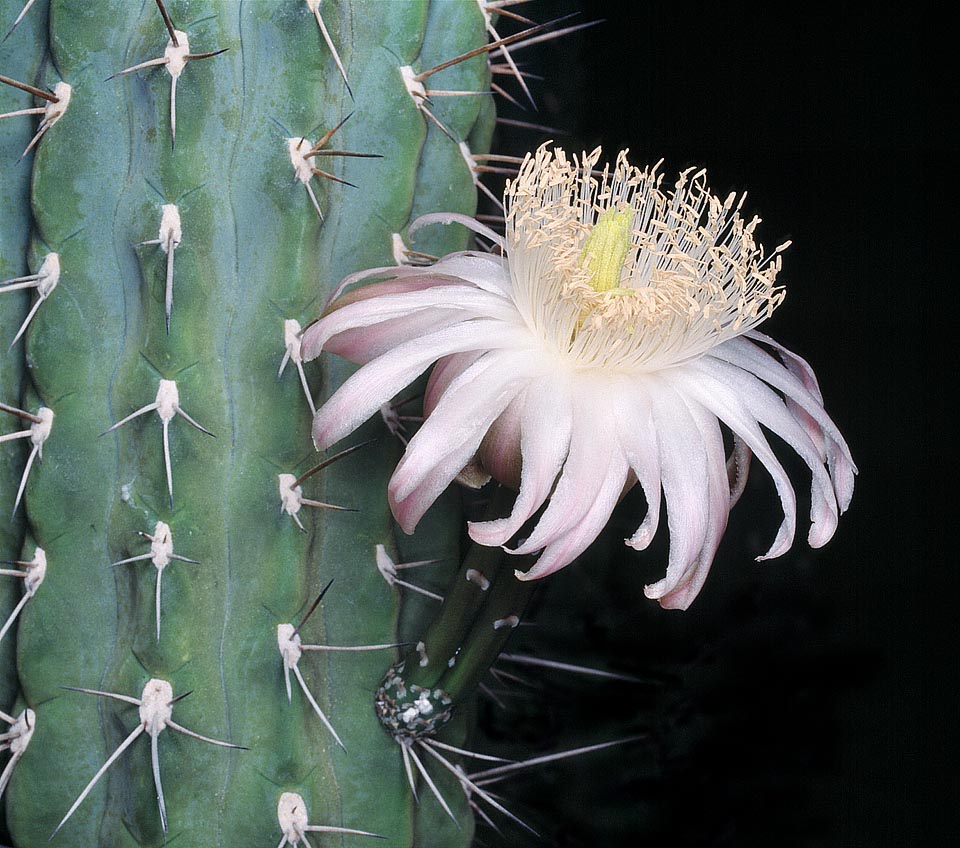Family : Cactaceae

Text © Pietro Puccio

English translation by Mario Beltramini
The Stetsonia coryne (Salm-Dyck) Britton & Rose (1920) is native to Argentina, Bolivia and Paraguay, where it mainly grows in woods of semi-deciduous xerophytes and savannahs, in plain areas or slightly high grounds between 300 and 800 m of altitude, often in salty soils.
The genus, containing the only species coryne, was honoured to the American lawyer Francis Lynde Stetson (1846-1920), passionate and sponsor of botanic expeditions; the name of the species comes from the Greek “koryne” = stick, club, with probable reference to the young plants not yet ramified.
Common names: “Argentine toothpick”, “toothpick cactus”, “toothpick saguaro” (English); “cardón”, “cardón moro” (Spanish).
Much ramified columnar plant which can reach a height of about 10 m with a crown of 5-8 m of diameter; the adult specimens have a short basal stem, with a height of 0,4-1 m and even 80 cm of diameter, with a corky surface covered by horizontal brown wrinkles from which originate several ascending stems, ramified too, of about 60 cm of length and 10-15 cm of diameter. The stems have 8-10 rounded ribs of green or glaucous-green colour with oval white areolas, regularly spaced, furnished of 6-8 radial thorns, long up to about 3 cm, and 1-2 central thorns which can reach a length of 8-10 cm; the thorns are yellowish brown or black tending to whiten with the time, but on the extremity.
The flowers come out laterally on the apical part of the stems, open during the night and can last 1-3 days, are funnel-shaped, 12-15 cm long and broad, with globose ovary, thickly covered by scales, cylindrical tube covered by similar, but more spaced scales, outer blunt and green tepals, whilst the inner ones are oblong, well stretched, of white colour.

This splendid 12-15 cm flower opens by night on ramified columnar stems that in Argentina, Bolivia and Paraguay may be 10 m tall with a crown of 5-8 m of diameter. The edible fruits are globular, smooth, juicy, of yellow or reddish colour, about 5-6 cm long with a diameter of 4 cm, and have the scent of the lemon © Giuseppe Mazza
Plant of remarkable ornamental value, suitable for great “desert” gardens, in areas with mild and dry winters. It is to be cultivated in full sun, or, however, at the most possible luminosity, on particularly draining soils, as it is rather sensitive the to radical rottenness due to stagnating humidity, which can be formed by about the 50% of common manured garden earth and by the remaining part, in equal quantity, by sand and crushed stones.
It can bear, in dry soil and for a very short time, temperatures as down as -4/-6 °C, but it is better not to expose it to temperatures lower than +10 °C; therefore, where the climate does not allow the cultivation in open air, it is to be cultivated in pot with the same modalities shown before. In summer, during the vegetative period, it is to be regularly watered, but allowing the soil to dry up completely before giving water again, in winter, it is to be kept dry.
In the origin countries the outer part of the fruit, without the seeds, with its strong taste which reminds the lemon, is eaten raw, the whole fruit only after cooking. The plant is inscribed into the appendix II of the Cites (plant whose trade is ruled at international level).
Synonymes: Cereus coryne Salm-Dyck (1850).
